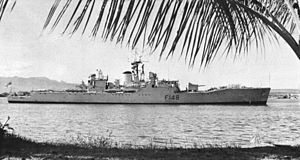HMNZS Taranaki (F148)

HMNZS Taranaki at Pearl Harbor c. 1963
|
|
| History | |
|---|---|
|
|
|
| Name: | Taranaki |
| Namesake: | Taranaki Province |
| Builder: | |
| Launched: | 19 August 1959 |
| Commissioned: | 28 March 1961 |
| Decommissioned: | 18 June 1982 |
| Struck: | 2 July 1982 |
| Fate: | sold and broken up |
| General characteristics | |
| Class and type: | Modified Rothesay-class frigate |
| Displacement: | 2,144 tonnes |
| Length: | 112 m (367 ft) |
| Beam: | 12 m (39 ft) |
| Draught: | 5 m (16 ft) |
| Propulsion: | 2-shaft double-reduction geared steam turbines |
| Speed: | 30 knots (56 km/h) |
| Range: | 400 tons oil fuel, 5,200 nautical miles (9,630 km) at 12 knots (22 km/h) |
| Complement: | originally 219, later 240 |
| Armament: |
|
HMNZS Taranaki (F148) was a modified Rothesay-class frigate in service with the Royal New Zealand Navy (RNZN) from 1960 to 1982. She, along with her sister ship Otago, formed a core part of the RNZN escort force throughout the 1960s and 1970s. She was named after Taranaki Province.
Taranaki's first crew arrived in Cowes on 27 March 1961 after a full military march from Plymouth, with the ship commissioned into the RNZN a day later. The new frigate had been fitted out with an impressive amount of fine worked wood panelling in the ward room and other joint facilities. She was formally handed over on 29 March after completing her final sea trials. She was however a dated design, beside the Tribal-class frigate, HMS Eskimo being built alongside it, with its fast starting gas turbines, ( cf, Taranaki's steam turbines which required 6 hours to heat up to take the frigate out of port) and the Tribal-class frigates, pad and hangar for the Wasp helicopters that were being trialed for torpedo attack at max sonar range, beyond the Limbo mortars capabilities.
The first decade of Taranaki's existence saw her take part in regular deployments to the Far East, to Hawaii, Australia and the Pacific for exercises with ships of other navies, and ‘show the flag’ tours.
Between 1974 and 1978, Taranaki was usually laid up due to a shortage of naval personnel. During this period while her hull and propulsion system remained in reasonable order, there was a substantial deterioration in the reliability of her combat systems and they ceased to be entirely viable. On the occasions that she was at sea she was mainly protecting New Zealand's Economic Exclusion Zone (EEZ).
...
Wikipedia
